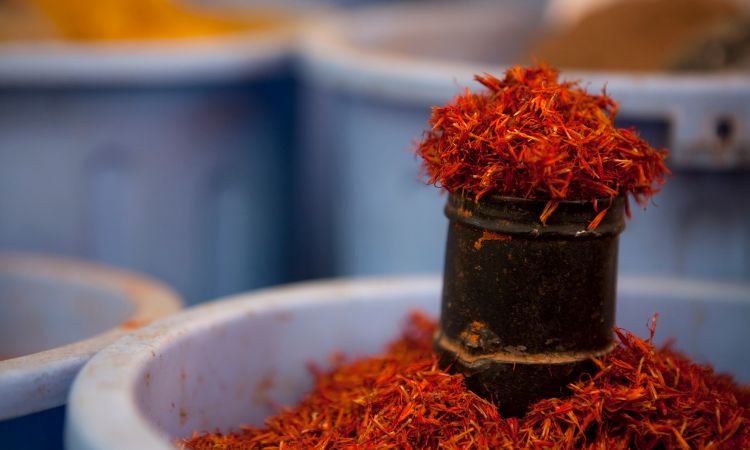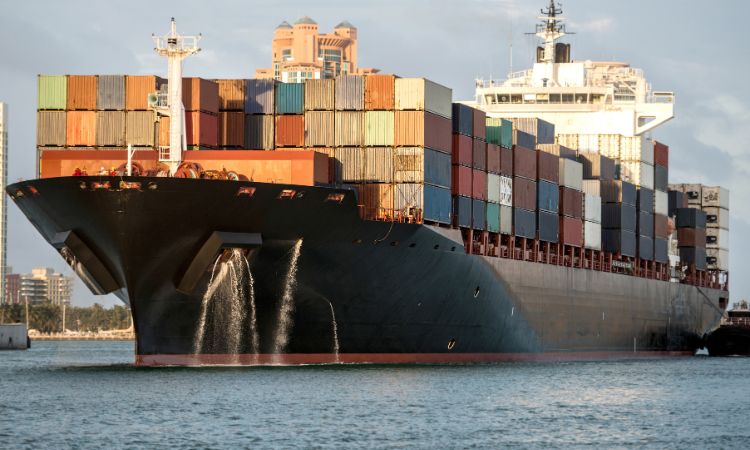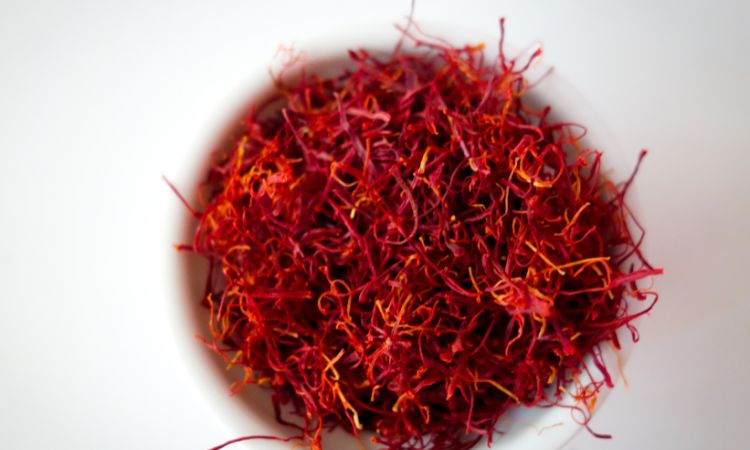The captivating story of saffron, a prized and precious spice, is interwoven with the ancient trade routes that connected civilizations across the globe. This flavorful journey takes us through the rich tapestry of history, where saffron’s influence shaped cultural exchanges, economic prosperity, and the very fabric of global commerce.
Originating in the heart of ancient Persia, saffron’s allure soon spread throughout the Mediterranean, reaching the shores of Egypt and the bustling markets of the Roman Empire. As the spice’s reputation for its vibrant hue, distinctive aroma, and medicinal properties grew, it became a sought-after commodity that traversed vast distances, forging connections between distant lands.
From the rugged Silk Road caravans to the intrepid maritime voyages, the ancient saffron trade routes carved a path across continents, fostering a rich tapestry of cultural exchange and economic prosperity. This captivating historical journey invites us to explore the stories hidden within the threads of Saffron’s global odyssey.
Key Takeaways
- Saffron’s origins in ancient Persia and its global diffusion through trade routes
- The influence of saffron on cultural exchange and economic growth across civilizations
- The development of intricate land and sea trade networks that facilitated the movement of this precious spice
- The enduring legacy of saffron’s historical significance in shaping global commerce and connectivity
- The ongoing fascination and contemporary revival of ancient saffron trade routes

The Origins of Saffron Trade in Ancient Civilizations
The rich tapestry of saffron’s history is woven through the ancient trade networks that spanned continents. From the dawn of civilization, this precious spice has captivated the world, with its vibrant hue and distinctive aroma playing a pivotal role in the cultural and economic exchange of ancient societies.
Early Persian Empire’s Role in Saffron Cultivation
The origins of the saffron trade can be traced back to the Persian Empire, where this prized spice was meticulously cultivated and prized for its medicinal and culinary applications. The Persians, renowned for their horticultural expertise, developed sophisticated techniques to maximize saffron’s yield, ensuring a steady supply for their flourishing trade networks.
Mediterranean Civilizations and Saffron Commerce
As the saffron spice roads extended their reach, the Mediterranean civilizations, such as ancient Greece and Rome, became integral players in the global saffron trade. These maritime powers leveraged their strategic coastal locations to establish thriving saffron markets, facilitating the exchange of this precious commodity with distant lands.
Ancient Egyptian Saffron Markets
Saffron’s allure extended beyond the Persian and Mediterranean regions, captivating the attention of the ancient Egyptians. The Nile River, a vital artery of commerce, witnessed the rise of bustling saffron markets, where the spice was highly prized for its use in religious rituals, cosmetics, and even mummification practices.
The enduring legacy of saffron’s historical trade routes continues to captivate and inspire, weaving a tapestry of cultural exchange and economic prosperity that has stood the test of time.
Major Saffron Trade Routes Across Continents
The ancient saffron trade was a testament to human ingenuity, as merchants and traders navigated intricate saffron caravan routes and saffron trade paths to transport this coveted spice across vast continents. From the Persian heartland to the Mediterranean shores, and beyond to the Far East, the global exchange of saffron transformed economies and cultures alike.
One of the most renowned saffron trade paths was the Silk Road, which facilitated the exchange of not just silk, but also the precious saffron. Caravans traversed rugged mountain passes and arid deserts, bringing the vibrant crimson threads to eager markets across Central Asia and Europe.
- The Silk Road connected major hubs like Samarkand, Bukhara, and Merv, where saffron was a prized commodity.
- Merchants from the Middle East, India, and China converged at these trading posts, exchanging goods and ideas.
- The spice’s versatility in culinary, medicinal, and ceremonial applications made it a sought-after treasure along these ancient saffron caravan routes.
In the Mediterranean region, saffron trade paths linked the great civilizations of Greece, Rome, and Egypt. Phoenician and Greek traders plied the seas, transporting saffron to the markets of Alexandria, Carthage, and beyond.
“Saffron was the gold of the ancient world, a rare and precious commodity that connected cultures and fueled the growth of mighty empires.”
The exchange of this vibrant spice not only enriched the coffers of traders but also fostered cross-cultural pollination, as culinary traditions, medicinal practices, and artistic influences traveled along with the coveted saffron.

The Silk Road Connection: Saffron’s Golden Path
The ancient saffron trade was intrinsically linked to the famed Silk Road, a sprawling network of overland trade routes that connected Asia, Africa, and Europe. Saffron’s journey across this vast network played a crucial role in the cultural and economic exchange that flourished along these storied paths.
Central Asian Trading Posts
The Silk Road’s Central Asian trading posts, such as Samarkand, Bukhara, and Merv, served as vital hubs for the saffron trade. These vibrant marketplaces facilitated the exchange of precious spice between merchants from diverse regions, fostering a rich tapestry of cultural interactions and the spread of saffron’s culinary and medicinal uses.
Cultural Exchange Along Saffron Routes
- The saffron-laden caravans that traversed the Silk Road enabled the transmission of culinary traditions, artistic influences, and medicinal knowledge across the ancient world.
- Saffron’s versatility as a pigment, dye, and flavoring agent made it a sought-after commodity, contributing to the cultural cross-pollination that defined the Silk Road experience.
Key Trading Cities and Merchants
| Trading City | Prominent Merchants |
|---|---|
| Samarkand | Ibn Battuta, Rumi |
| Bukhara | Al-Biruni, Nasir Khusraw |
| Merv | Yaqut al-Hamawi, Mahmud of Ghazni |
These vibrant trading hubs and the merchants who operated within them were instrumental in shaping the global reach and impact of the saffron silk roads and saffron overland routes.
Maritime Routes and Saffron Transportation
While the saffron trade networks on land were crucial, the maritime routes played a vital role in the global distribution of this precious spice. The saffron maritime routes connected distant civilizations, allowing the vibrant orange threads to reach far-flung corners of the ancient world.
Ancient seafarers navigated treacherous waters, harnessing the power of wind and waves to transport saffron across vast oceans. Merchant ships, laden with fragrant cargo, traversed the Mediterranean, the Red Sea, and the Indian Ocean, linking the shores of civilizations from the Levant to Southeast Asia.
The maritime trade in saffron was not without its challenges. Storms, pirates, and unpredictable currents threatened the safe passage of the valuable cargo. Yet, the rewards of successful voyages were immense, as saffron’s popularity and prestige continued to soar across the ancient world.
The mastery of maritime navigation and the establishment of reliable trade routes played a pivotal role in the global distribution of saffron. This spice, once the domain of a few privileged regions, now found its way into the kitchens and ceremonial practices of diverse cultures, thanks to the ingenuity and determination of ancient seafaring merchants.
| Major Saffron Maritime Routes | Key Trading Hubs |
|---|---|
|
|
The resilience and adaptability of the saffron maritime trade networks were critical in shaping the global diffusion of this coveted spice, connecting diverse civilizations and fostering cultural exchange across continents.

Ancient Saffron Trading Techniques and Storage
The ancient world’s fascination with the vibrant crimson threads known as saffron extended far beyond their culinary and medicinal applications. The intricate web of historical saffron trade paths was not only a testament to the spice’s value but also a showcase of the ingenuity and resourcefulness of ancient traders and merchants.
Preservation Methods in Transit
Transporting saffron across vast distances posed significant challenges for ancient traders. To ensure the delicate spice’s quality and freshness, they developed innovative preservation techniques. One such method involved carefully packing the saffron in airtight containers lined with beeswax or tree resins, which helped to lock in the aroma and prevent oxidation. Additionally, some traders used aromatic herbs and spices as natural preservatives, further enhancing the saffron’s longevity during the arduous journeys along the historical saffron routes.
Trading Vessels and Containers
- Traders along the saffron trade paths employed a variety of vessels to transport their precious cargo, from sturdy caravans and pack animals to sleek maritime ships.
- Saffron was often packed in specialized containers, such as woven baskets, ceramic jars, or wooden crates, to protect it from the elements and minimize damage during transport.
- The choice of vessel and container was crucial, as it had to balance the need for security, ventilation, and efficient storage to ensure the saffron’s quality remained intact upon arrival at its destination.
Quality Control Measures
To maintain the reputation and value of saffron, ancient traders implemented rigorous quality control measures. This involved meticulous inspection of the spice at various stages of the historical saffron routes, from the initial harvesting to the final sale. Traders often employed experienced evaluators who could assess the saffron’s color, aroma, and purity, rejecting any batches that did not meet their exacting standards. This attention to detail helped to establish saffron as a premium commodity, sought after by discerning buyers across the ancient world.
Economic Impact of Historical Saffron Trade
The ancient saffron trade routes not only facilitated cultural exchange but also had a profound economic impact on the regions they traversed. As a highly prized spice, saffron was a valuable commodity that drove wealth creation and shaped the economic fortunes of civilizations along the saffron trade routes.
One of the key economic impacts of the ancient saffron trade was its role in stimulating regional prosperity. Saffron-producing areas, such as Persia and the Mediterranean, became hubs of economic activity, attracting merchants, traders, and artisans who sought to capitalize on the spice’s popularity. This influx of commerce and investment led to the development of thriving marketplaces, the growth of urban centers, and the emergence of a prosperous merchant class.
Moreover, the saffron trade had a significant influence on the distribution of wealth across the ancient world. As the spice was highly valued, its trade generated substantial profits for those involved, leading to the accumulation of wealth in the hands of a few. This concentration of wealth, in turn, fueled the development of luxurious lifestyles, patronage of the arts, and the construction of grand architectural projects in the major trading hubs.
| Region | Economic Impact of Saffron Trade |
|---|---|
| Persia | Saffron cultivation and trade drove the growth of urban centers, fostering a thriving merchant class and supporting the Persian Empire’s economic power. |
| Mediterranean Civilizations | The demand for saffron in Greece, Rome, and Egypt led to the establishment of extensive trade networks, stimulating economic development and prosperity in coastal regions. |
| Central Asia | Saffron trade routes, such as the Silk Road, facilitated the exchange of goods and ideas, contributing to the economic growth of major trading cities like Samarkand and Bukhara. |
The economic impact of the historical saffron trade routes is a testament to the spice’s enduring value and its ability to shape the fortunes of ancient civilizations. From driving regional prosperity to influencing the distribution of wealth, saffron’s role in the ancient world’s economy remains a captivating aspect of its rich history.
Cultural Significance Along Saffron Trade Routes
As the fragrant saffron spice journeyed along the historic trade routes, it wove itself into the fabric of diverse cultures, leaving an indelible mark on religious traditions and culinary exchange.
Religious and Ceremonial Uses
Saffron, the world’s most expensive spice, held profound spiritual significance in many ancient civilizations. Along the saffron spice roads and saffron caravan routes, the golden threads were revered for their ability to evoke the divine. In Persia, saffron was used extensively in religious ceremonies, imbuing rituals with its vibrant hue and distinct aroma. Similarly, the ancient Greeks and Romans incorporated saffron into sacred practices, from temple offerings to celebratory processions.
Culinary Traditions and Exchange
As merchants and traders traversed the intricate web of saffron spice roads and saffron caravan routes, they not only transported the coveted spice but also exchanged culinary knowledge and traditions. From the fragrant saffron-infused rice dishes of Central Asia to the decadent saffron-laced desserts of the Mediterranean, the golden strands became a unifying element in diverse cuisines. This cultural cross-pollination enriched the gastronomic landscape, creating a tapestry of flavors that still captivates the senses today.
“Saffron was more than just a spice; it was a symbol of wealth, status, and cultural exchange along the ancient trade routes.”

Merchants and Traders: Key Historical Figures
The ancient saffron trade networks and saffron silk roads were shaped by the visionary efforts of numerous merchants and traders who traversed continents, forging cultural and commercial exchanges. These intrepid individuals played pivotal roles in the rise and evolution of one of the world’s most precious spice trades.
Among the most renowned figures in saffron trade history was Ibn Battuta, the Moroccan explorer and scholar who documented his extensive journeys across the medieval world. Battuta’s detailed accounts shed light on the thriving saffron markets he encountered, from the bustling souks of Persia to the vibrant trading posts of Central Asia.
- Battuta’s writings offer invaluable insights into the intricate web of saffron trade routes, highlighting the merchant communities that drove this lucrative commerce.
- His observations underscore the cultural significance of saffron, noting its use in religious ceremonies and culinary traditions across diverse civilizations.
Another prominent historical figure was the Venetian merchant Marco Polo, whose legendary travels along the saffron silk roads cemented his legacy as a pioneering explorer. Polo’s accounts provide a vivid glimpse into the logistical challenges and trading practices that defined the saffron trade, from the preservation of the delicate spice to the negotiation of tariffs and customs duties.
| Merchant | Origin | Contribution to Saffron Trade |
|---|---|---|
| Ibn Battuta | Morocco | Documented thriving saffron markets and trade routes across the medieval world |
| Marco Polo | Venice | Detailed accounts of logistical challenges and trading practices along the saffron Silkroads |
The stories of these remarkable individuals underscore the enduring significance of the saffron trade networks and the pivotal role played by merchants and traders in shaping the global exchange of this precious commodity.
Challenges and Conflicts in Saffron Trade Routes
The ancient saffron trade routes, both maritime and overland, were not without their fair share of obstacles and conflicts. From natural challenges to political barriers, the spice merchants and traders of the past had to navigate a treacherous path to ensure the seamless flow of the coveted saffron across continents.
Natural Obstacles and Solutions
The saffron maritime routes, which connected the Mediterranean civilizations to the Far East, faced numerous natural hurdles. Harsh weather conditions, unpredictable tides, and perilous sea voyages posed constant threats to the safety of cargo and crew. Seasoned captains and sailors, however, developed innovative techniques to overcome these challenges, such as optimizing shipping schedules, utilizing favorable wind patterns, and implementing robust storage methods to preserve the delicate saffron.
Similarly, the saffron overland routes traversing Central Asia and the Silk Road encountered their fair share of natural obstacles. Treacherous mountain passes, shifting desert landscapes, and the risk of bandit attacks required meticulous planning and resourceful solutions from the caravans. Traders leveraged local knowledge, constructed fortified caravanserais, and formed alliances with nomadic communities to navigate these treacherous routes safely.
Political Barriers and Negotiations
In addition to the natural challenges, the saffron trade routes also faced political obstacles. Shifting borders, territorial conflicts, and the imposition of tariffs and customs duties by various empires and kingdoms threatened the smooth flow of the spice. Savvy merchants and diplomats, however, navigated these political landscapes through strategic negotiations, forging alliances, and leveraging their economic influence to ensure the continuous trade of saffron.
The ability to overcome these challenges, both natural and political, was a testament to the resilience and adaptability of the saffron trade networks. The spice’s enduring value and the determination of those who transported it across vast distances paved the way for the cultural and economic exchange that defined the ancient world.
Legacy of Ancient Saffron Commerce
The historical journey of the ancient saffron trade has left an indelible mark on our world, shaping modern commerce, cultural exchange, and culinary traditions. The historical saffron routes that once traversed continents have not only influenced global trade but also fostered the spread of ideas, traditions, and culinary influences that continue to resonate today.
One of the notable legacies of the ancient saffron trade is its impact on global cuisine. The vibrant yellow hue and distinctive flavor of saffron, once the domain of elite and royal tables, have become integral to the culinary fabric of many cultures. From the fragrant saffron-infused rice dishes of the Middle East to the decadent saffron-laced pastries of Europe, the spice’s influence has transcended boundaries and become a cherished ingredient worldwide.
Beyond its culinary impact, the ancient saffron trade also played a pivotal role in fostering cultural exchange and diplomatic relations. The extensive trade networks that connected distant civilizations facilitated the flow of not only goods but also ideas, technologies, and artistic traditions. The exchange of knowledge and the intermingling of cultures along the historical saffron routes have left an indelible mark on the world, shaping the rich tapestry of our shared heritage.
Today, the legacy of the ancient saffron trade continues to inspire and captivate, with growing interest in heritage tourism and the exploration of these storied trade paths. Travelers and adventurers alike are drawn to the allure of the historical saffron routes, seeking to immerse themselves in the rich history, vibrant cultures, and timeless traditions that have endured through the centuries.
| Legacy of Ancient Saffron Commerce | Impact |
|---|---|
| Culinary Influence | Saffron is a cherished ingredient in global cuisines |
| Cultural Exchange | Spread of ideas, traditions, and artistic expressions |
| Heritage Tourism | Growing interest in exploring historical saffron trade routes |
“The legacy of the ancient saffron trade continues to captivate and inspire, reminding us of the enduring power of global exchange and the enduring allure of this precious spice.”
Modern Revival of Historical Trade Paths
The ancient saffron trade routes have experienced a remarkable resurgence in recent times, as the global demand for this precious spice has skyrocketed. Today, saffron markets across the world are thriving, with producers and consumers reconnecting to the rich history and cultural legacy of this age-old commodity.
Contemporary Saffron Markets
The saffron industry has undergone a significant transformation, with modern cultivation techniques and supply chain innovations. Leading producers like Iran, Spain, and Greece are leveraging their historical advantages to meet the growing international appetite for saffron. Innovative marketing strategies, such as traceability programs and branded products, have further boosted the appeal of this unique spice in contemporary markets.
Heritage Tourism Along Ancient Routes
Alongside the resurgence of saffron trade, there is a rising interest in exploring the ancient pathways that once connected civilizations through this precious commodity. Heritage tourism has emerged as a vibrant segment, allowing travelers to retrace the steps of historical merchants and immerse themselves in the cultural tapestry of the saffron spice roads. From the bustling souks of Iran to the scenic landscapes of Central Asia, these ancient trade routes are becoming hubs of cultural exchange and experiential learning.
FAQ
What were the major ancient saffron trade routes?
The ancient saffron trade routes connected various civilizations across continents, including the Silk Road, maritime routes, and overland caravan paths. These trade networks facilitated the exchange of this precious spice and shaped cultural, economic, and culinary traditions worldwide.
How did the Persian Empire contribute to the saffron trade?
The Persian Empire played a crucial role in the cultivation and distribution of saffron. They established large-scale saffron production and developed intricate trade networks to transport the spice across the region and beyond.
What were some of the key trading cities and merchants involved in the saffron trade?
Important trading cities along the saffron routes included Central Asian hubs like Samarkand and Bukhara, as well as Mediterranean ports such as Alexandria and Antioch. Prominent merchants and traders, such as those from the Silk Road caravans, facilitated the exchange of saffron across vast distances.
How did saffron influence cultural exchange and culinary traditions?
Saffron’s cultural significance was deeply intertwined with its trade routes. The spice was used in religious ceremonies, culinary dishes, and as a dye, fostering the exchange of traditions and techniques across civilizations along the trade paths.
What were some of the challenges and conflicts encountered in the ancient saffron trade?
Traders and merchants faced various obstacles, including natural barriers like harsh terrain and weather, as well as political tensions and conflicts along the trade routes. Overcoming these challenges required innovative solutions and negotiation skills.
How has the legacy of ancient saffron trade influenced modern commerce and cultural exchange?
The historical saffron trade has left a lasting impact, shaping modern trade networks, global culinary traditions, and cultural exchange. Contemporary saffron markets and heritage tourism along ancient routes continue to celebrate the enduring legacy of this precious spice.





